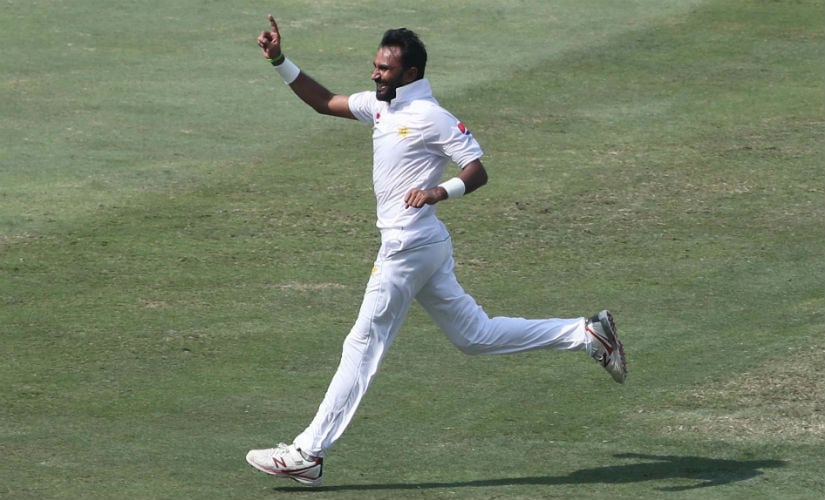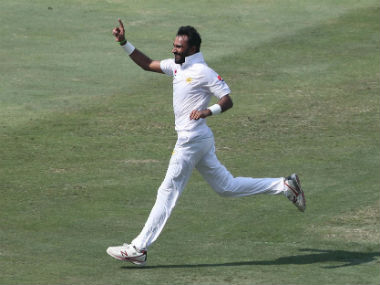Four years ago, Pakistan ‘hosted’ Australia in the UAE — it was their first ‘home’ series against Australia in 12 years, and the first time they had hosted them in environs familiar to them in 17 years. Six months earlier Australia had climbed to the top of the ICC rankings, winning seven of eight Tests against England and South Africa. The Australians, under Darren Lehmann, were “back” — mustachioed fast bowlers, a take-no-prisoners attitude and a return to what had supposedly made them great were the order of the day. Pakistan, meanwhile, were in a funk. They hadn’t won a Test series for two years, were without both Abdur Rehman and Saeed Ajmal — the spin twins that had made the desert a fortress for them until then — as well as two of their best fast bowlers in the years leading up to that series (Umar Gul and Junaid Khan), and with the World Cup around the corner, even had question marks about their captain. The state of depletion of Pakistan’s resources was such that the four-man bowling unit that Pakistan fielded for the first Test of the series had a combined playing career of eight Tests until then. [caption id=“attachment_5353961” align=“alignnone” width=“825”]  Bilal Asif marked his Test debut at the age of 33 with a haul of 6/36. AFP[/caption] Pakistan won that series by inflicting two of the 25 heaviest losses Australia have ever suffered (by margin of runs). The bowling unit may have been inexperienced at the highest level, but they had years of experience in the domestic game, where knowing your limitations and maximising the conditions is the modus operandi. Pakistan dominated that series, and it kickstarted their two-year, seven unbeaten series, long journey to the Test mace. At the time of that series, Bilal Asif could best be described as a club cricketer. At the age of 29, he had played only six First Class and 17 List A matches until then — never scoring a fifty or taking a four-fer in that time. A year later he was a member of the Pakistan team, and it wasn’t long before he was out of the side, and soon a forgotten man. It had been an extraordinary 12 months in a remarkable life. Bilal grew up idolising Saqlain Mushtaq, but there was inspiration closer to home too. He is the nephew of Zahid Saeed, a former wunderkind who never made it to the top. Saeed had been the highest wicket taker in the 1999/2000 Under-19 World Cup, ahead of the likes of Danish Kaneria, Nathan Hauritz and James Franklin. But, despite a successful domestic career, he played his last First Class match before even turning 25 — the life of a cricketer with no international prospects is a hard one in Pakistan, after all. With him, perhaps as a precaution, and considering the state of his household, Bilal could not follow his dream.
Unable to make it beyond the club game, he bade farewell to cricket, and did what so many South Asian young men do when in financial difficulty — he traveled to the Gulf for work. Bilal spent his early to mid-twenties, an age where his contemporaries were fine-tuning their cricketing skills, as an electrician in Kuwait.
A decade after making this career change, there were a bunch of Australians who were wishing that he had stuck to that vocation. Bilal returned to Pakistan in 2011, determined to try his hand one more time at the sport he loved. Over the next four years he was in-and-out of the Sialkot team, and was branded as a player who was too good for club cricket, but not good enough for a higher level. What he did have though, was the fortune of playing for the same region and club (Towne Brothers) as Shoaib Malik, who just happened to be in the middle of his own forced sabbatical from the international game. Malik thus became a mentor to Bilal, as he was for a whole generation of Sialkotis at that time (more on that in a bit). The season when Pakistan regained their mojo (2014/15), also turned out to be the season that changed Bilal’s career. He played more First Class matches than he ever had, took his first five-fer in that format, took two four-fers in List A cricket, and finished the season by winning the Super-8 T20 tournament in Faisalabad, en route to which he scored the fastest T20 hundred in Pakistan’s history. He started the following season under the spotlight, but he shined due to it. In the National T20 Cup he finished as the highest wicket-taking spinner and bagged the award for the best all-rounder in the tournament. Thus it was inevitable that with Shahid Afridi retired from the ODI game and a lack of off-spinners in domestic cricket after an ICC-inspired clamdown against bowling actions of a year earlier, Pakistan turned to Bilal as a potential replacement. The merits of selecting a player for ODIs due to the two T20 tournaments is a debate we’ll leave for another day, but Bilal’s rise had been meteoric — too meteoric for some: Suddenly, he was not a story to be emulated, but one to be envied, whispered about and disparaged. He began his international career with a five-wicket haul against Zimbabwe, but failures with the bat and with his action being reported, he was termed not good enough for the international game. He was cleared after testing, with ICC stating that his bowling action “was well within the 15-degree level of tolerance permitted under the ICC regulations”, but he was no longer the flavor of the month, which is all that seems to matter in Pakistan cricket. Over the next three years he was pulled down, ignored and belittled within the domestic game, and yet selected nearly every time Pakistan had a Test series in the UAE. He became one of the examples of stunted discourse in Pakistan cricket. Even in the lead-up to the current series against Australia, he was repeatedly compared unfavorably to Kashif Bhatti, who had far better domestic numbers, despite the fact that Bhatti is a slow left-arm bowler, while Bilal is a rare commodity in Pakistan cricket — a genuine off-spinner. Pakistan were looking for a spinner who could take the ball away from Australia’s army of left handers and thus compliment Yasir Shah and Shadab Khan, but that was not something that was part of the media discourse. With the disappointment of the Asia Cup as the context, Bilal became a stick to beat the team management and selectors with, through no fault of his own. It all changed however on Tuesday in Dubai. A little over 21 overs of sharp spin, natural bounce, multiple variations and deadly accuracy later, there was a lot humble pie being served in the country. There was one city, though, where they never had any doubts over him. The final word, as mentioned earlier, belongs to Malik and the city of Sialkot. Over the course of this decade, no senior player in Pakistani cricket has mentored and promoted the players of his city quite like Malik has. Within Pakistan cricket circles, only Karachiites are considered more loyal and predisposed towards their city than Sialkotis, and that’s something that Malik has fostered too. Then there’s the city itself. A third the size of neighbouring Gujranwala, and just one-twentieth the size of Lahore (which is less than 80 miles away), Sialkot should be a small city lost in the GT Road urban agglomeration, but instead it’s the pound-for-pound sporting center of the country. It’s the home to an export-driven economy, which is founded upon sporting goods. From Sachin Tendulkar asking Wasim Akram for a bat from Sialkot in the mid-1990s to over 42 million footballs being exported from the city for the 2014 FIFA World Cup, there is a longstanding sports infrastructure in the city. The result of which is a class of industrialists with interest in, and respect for, sportsmen, and thus patronise the game of cricket in the city. While the rest of the country complains about a failing grassroots structure, Sialkot — thanks to its nature — remains separated from that conversation, continuing to produce more talent than its population ought to. And with Haris Sohail, Mohammad Abbas and Bilal about to win Pakistan only their third Test against Australia in over 20 years, perhaps it’s time the rest of the country learnt from that city too.


)

)
)
)
)
)
)
)
)



